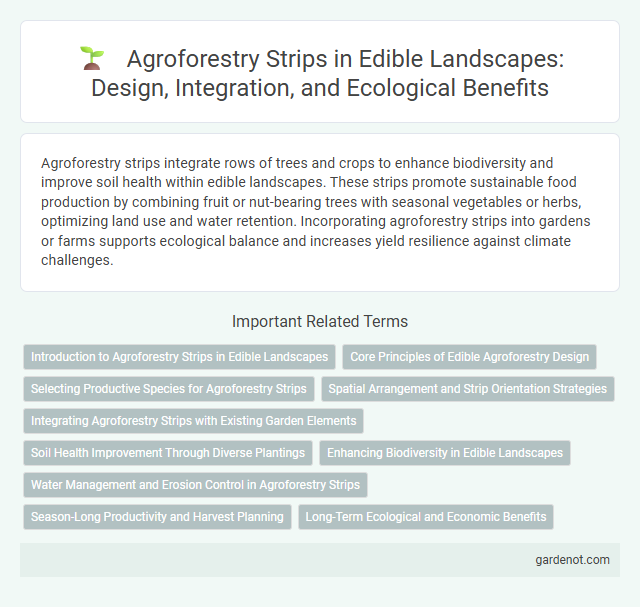Agroforestry strips integrate rows of trees and crops to enhance biodiversity and improve soil health within edible landscapes. These strips promote sustainable food production by combining fruit or nut-bearing trees with seasonal vegetables or herbs, optimizing land use and water retention. Incorporating agroforestry strips into gardens or farms supports ecological balance and increases yield resilience against climate challenges.
Introduction to Agroforestry Strips in Edible Landscapes
Agroforestry strips integrate rows of trees and shrubs with crops or livestock, enhancing biodiversity and soil health in edible landscapes. These strips improve nutrient cycling, reduce erosion, and provide diverse food sources such as fruits, nuts, and medicinal plants. Implementing agroforestry strips promotes sustainable land use by combining agricultural productivity with ecological benefits.
Core Principles of Edible Agroforestry Design
Agroforestry strips integrate diverse plant species to enhance soil fertility, promote biodiversity, and optimize land use efficiency within edible landscapes. Key principles include layering crops vertically to maximize sunlight absorption, selecting complementary species for mutual benefits such as nitrogen-fixing and pest deterrence, and establishing resilient ecosystems that improve water retention and reduce erosion. Designing edible agroforestry strips involves understanding plant interactions, lifecycle timing, and site-specific conditions to create sustainable food production systems.
Selecting Productive Species for Agroforestry Strips
Selecting productive species for agroforestry strips involves prioritizing plants that offer high yields, resilience to local climate, and compatibility with neighboring crops. Key species include nitrogen-fixing trees like Acacia or Albizia, fruit-bearing shrubs such as Vaccinium or Ribes, and perennial vegetables that promote soil health and biodiversity. Proper species selection maximizes multifunctional benefits, including food production, soil enrichment, and habitat provision within edible landscapes.
Spatial Arrangement and Strip Orientation Strategies
Agroforestry strip design optimizes spatial arrangement by integrating alternating bands of trees and crops to enhance biodiversity, improve soil fertility, and maximize land use efficiency. Strip orientation typically aligns with contour lines or prevailing wind directions to reduce erosion, improve microclimate conditions, and increase sunlight exposure for crops. Strategic placement of species within strips promotes resource sharing and supports sustainable edible landscape systems.
Integrating Agroforestry Strips with Existing Garden Elements
Integrating agroforestry strips with existing garden elements enhances biodiversity and soil health by combining trees, shrubs, and perennial crops within traditional garden layouts. This method promotes efficient nutrient cycling and water retention, supporting diverse plant species and improving overall garden productivity. Strategic placement of agroforestry strips near vegetable beds or pollinator-friendly plants maximizes ecosystem services while maintaining aesthetic harmony.
Soil Health Improvement Through Diverse Plantings
Agroforestry strips enhance soil health by incorporating diverse plant species that increase organic matter and promote nutrient cycling. The varied root systems improve soil structure and prevent erosion, while nitrogen-fixing plants naturally enrich soil fertility. This biodiversity-driven approach supports microbial activity, leading to sustainable soil regeneration and long-term productivity in edible landscapes.
Enhancing Biodiversity in Edible Landscapes
Agroforestry strips integrate diverse tree species and crops to create habitats that support beneficial insects, birds, and soil microorganisms. This multifaceted approach enhances biodiversity by promoting ecological balance and improving pollination and pest control within edible landscapes. Strategic plant layering and species selection within agroforestry strips optimize nutrient cycling and increase resilience against environmental stresses.
Water Management and Erosion Control in Agroforestry Strips
Agroforestry strips enhance water management by improving soil infiltration and reducing surface runoff, which conserves moisture critical for crop growth. These strips act as natural barriers that slow down water flow, minimizing soil erosion and promoting sediment deposition. Integrating deep-rooted trees and diverse vegetation stabilizes soil structure, increasing resilience against water-related degradation.
Season-Long Productivity and Harvest Planning
Agroforestry strips enhance season-long productivity by integrating diverse crop species that mature at different times, ensuring continuous harvest throughout the growing season. Strategic harvest planning in these systems optimizes resource use, balances labor demands, and maintains soil health while maximizing yield. Incorporating nitrogen-fixing trees and perennial shrubs improves nutrient cycling, supporting sustained productivity and long-term agroecosystem resilience.
Long-Term Ecological and Economic Benefits
Agroforestry strips combine trees and crops to enhance biodiversity while improving soil health, water retention, and carbon sequestration over time. These systems provide sustainable income through diversified yields, including fruits, nuts, and timber, reducing economic risks for farmers. Long-term ecological stability and increased land productivity make agroforestry strips a vital strategy for resilient edible landscapes.
Agroforestry strip Infographic

 gardenot.com
gardenot.com